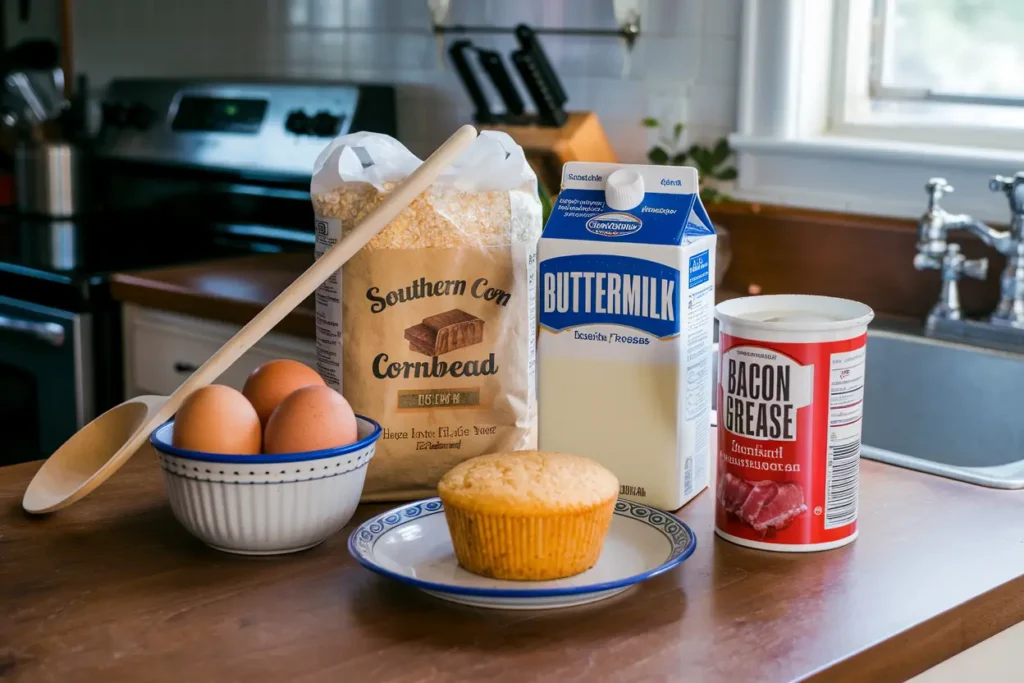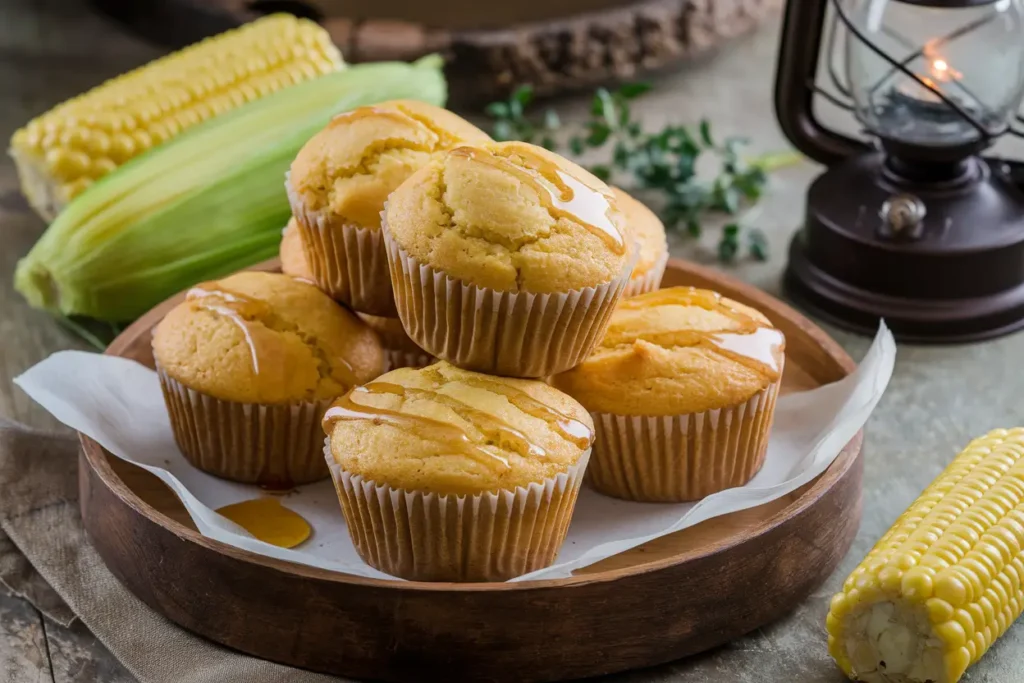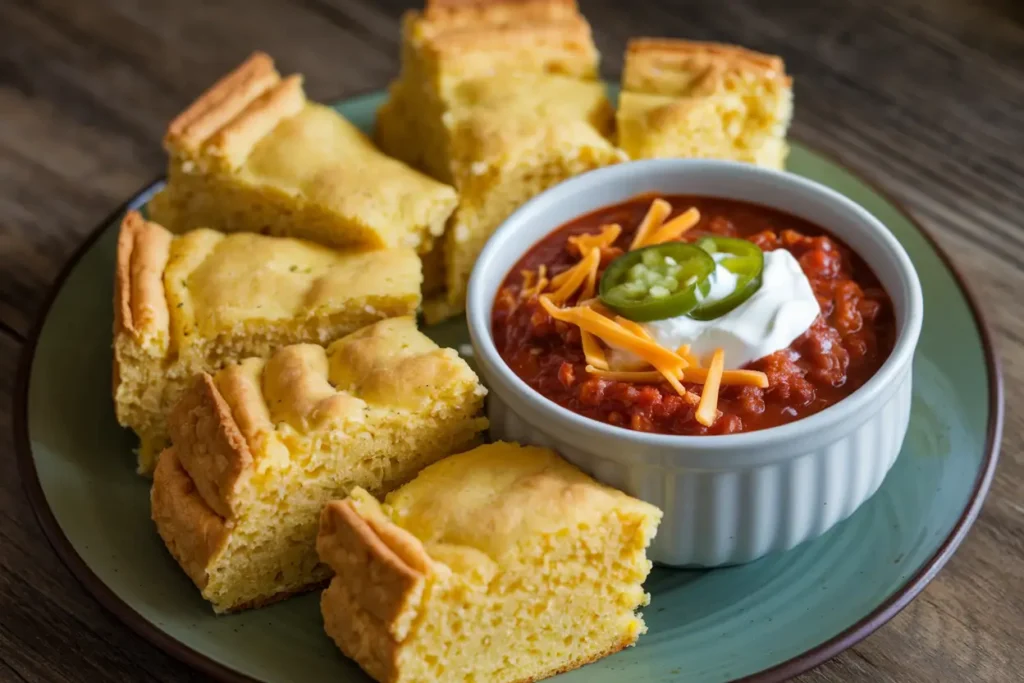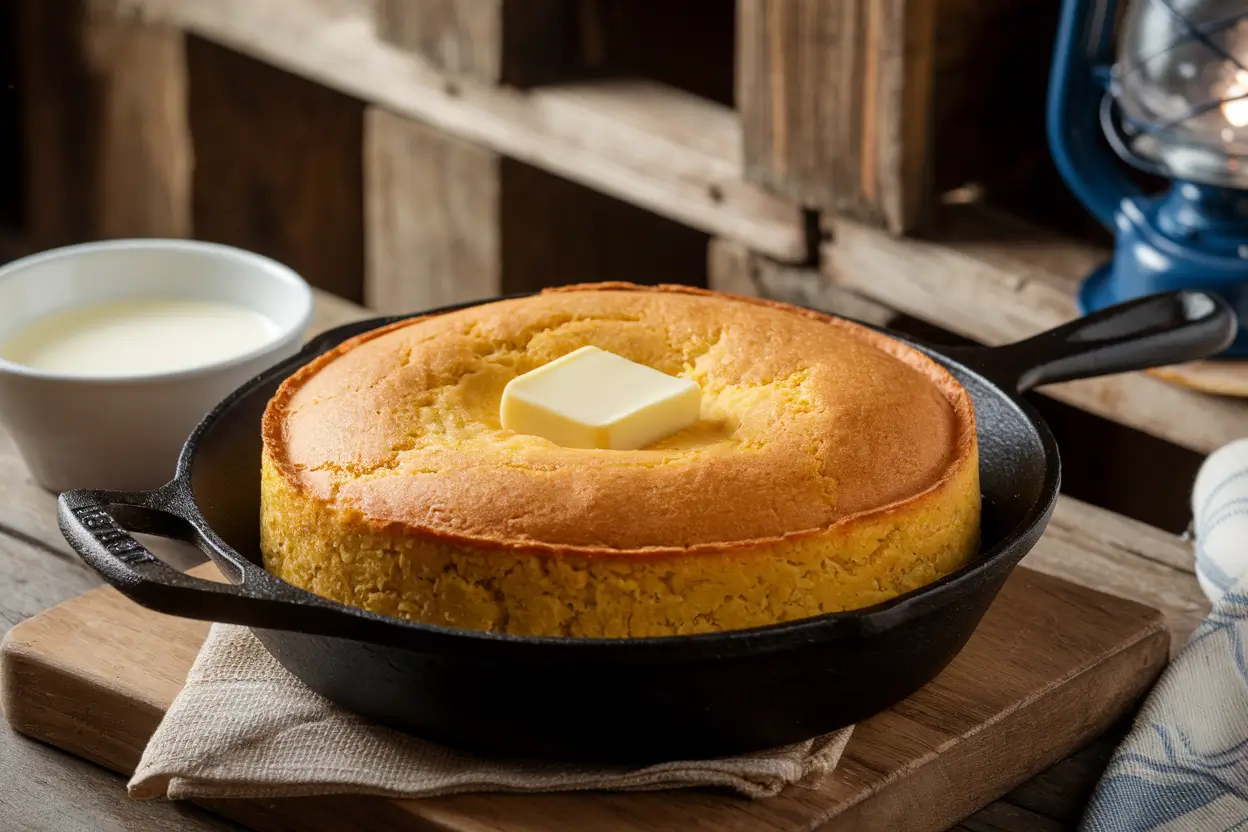Southern cornbread is a timeless dish, bringing comfort and tradition to tables across the South. This classic Southern cornbread recipe is more than just food—it’s a symbol of hospitality, heritage, and heartwarming flavors. Whether you’re a first-time baker or a seasoned cook, this guide will walk you through everything you need to know about making the perfect Southern cornbread recipe.
Table of Contents
What is Southern Cornbread?
Southern cornbread recipe stands apart from its sweeter Northern counterpart. Known for its savory flavor, crunchy edges, and tender crumb, it’s traditionally made with simple ingredients like cornmeal, buttermilk, and eggs. It’s often baked in a cast-iron skillet, which gives it that signature crispy crust.
The History Behind Southern Cornbread Recipe
Southern cornbread recipe has deep roots in Native American cuisine, where ground corn was a staple. European settlers adopted the use of cornmeal, combining it with their cooking methods to create what we now recognize as cornbread. Over time, this humble bread became a household favorite, especially in the South, where it paired perfectly with dishes like collard greens and fried chicken.
Key Ingredients in Traditional Southern Cornbread

To make authentic Southern cornbread recipe, you’ll need a few essential ingredients:
Cornmeal: The Heart of Southern Cornbread Recipe
The quality of your cornmeal can make or break your recipe. Stone-ground cornmeal is often preferred for its rich flavor and texture.
Buttermilk or Milk: Which to Use and Why?
Buttermilk adds a slight tanginess and extra moisture. Find out “Is it better to use milk or buttermilk in cornbread?” to see which works best for you.
Fat Choices: Bacon Grease, Butter, or Oil?
Bacon grease is a Southern staple, adding a smoky depth to your cornbread. Butter brings richness, while oil provides a neutral option.
Pro Tip: Preheat your skillet with bacon grease for a perfectly crispy crust!
Step-by-Step Southern Cornbread Recipe
Here’s a foolproof recipe to create the ultimate Southern cornbread. Follow these steps, and you’ll have a golden masterpiece in no time.
Tools and Equipment You’ll Need
- Cast-iron skillet
- Mixing bowls
- Whisk or fork
- Measuring cups and spoons
The Perfect Cornmeal-to-Liquid Ratio
For a moist yet firm cornbread, stick to this classic ratio:
1 cup cornmeal : 1 cup buttermilk : 1 egg. Adjust based on your skillet size and desired thickness.
Baking Tips for Golden-Brown Cornbread
- Preheat your cast-iron skillet in the oven at 425°F (218°C).
- Mix dry ingredients (cornmeal, baking powder, salt) and wet ingredients (buttermilk, egg) separately before combining.
- Pour batter into the hot skillet to hear that satisfying sizzle—this ensures a crispy crust.
Common Mistakes to Avoid
- Using cold ingredients: Always let eggs and buttermilk come to room temperature.
- Overmixing: Stir just until combined to avoid dense cornbread.
- Skipping the preheated skillet: This step is non-negotiable for the perfect crust.
“Cornbread is like a warm hug for your taste buds. Treat it with love, and it’ll reward you with flavor.” ❤️
Variations of Southern Cornbread Recipe

Southern cornbread is incredibly versatile! Let your creativity shine with these fun twists:
Sweet vs. Savory Cornbread
While traditional Southern cornbread is savory, you can sweeten it up with a tablespoon or two of sugar or honey for a Northern-inspired flavor.
Adding a Twist: Jalapeños, Cheese, or Honey
- Spicy Kick: Add diced jalapeños or red pepper flakes.
- Cheesy Goodness: Fold in shredded cheddar cheese.
- Sweet Touch: Drizzle with honey right out of the oven.
Gluten-Free Southern Cornbread Options
Swap all-purpose flour for almond or rice flour to make your cornbread gluten-free without compromising flavor.
Serving Suggestions for Southern cornbread recipe

Southern cornbread pairs wonderfully with hearty dishes like soups, stews, and barbecue. Some perfect meal pairings include:
- “Corn chowder recipe: Creamy delight that warms the soul 🌽” – The rich, creamy texture complements the crumbly cornbread.
- “Baked beans recipe: Comfort food you’ll crave” – A classic Southern side dish that pairs beautifully with warm, buttery cornbread.
- “Salisbury steak recipe: Easy, hearty, and perfect comfort food” – A wholesome dish that goes great with cornbread for soaking up the delicious gravy.
Cornbread is a versatile side that pairs beautifully with a variety of dishes.
The Perfect Pairings: Southern Dishes to Try
- Fried chicken
- Collard greens
- Chili
Leftover Cornbread Ideas: Croutons, Dressing, and More
Don’t let leftovers go to waste! Turn them into:
- Croutons for salads or soups.
- Cornbread dressing for a hearty casserole.
- Cornbread pudding for a sweet treat.
FAQs About Southern cornbread recipe
Can You Make Southern Cornbread Without Eggs?
Yes! Replace eggs with a flaxseed meal and water mixture or applesauce for a vegan-friendly option.
How to Store and Reheat Cornbread Properly?
- Storage: Wrap cornbread tightly and store at room temperature for up to two days or refrigerate for up to a week.
- Reheating: Warm in the oven at 300°F for 10 minutes.
What’s the Best Type of Skillet for Cornbread?
A well-seasoned cast-iron skillet is the top choice. It ensures even cooking and delivers that iconic crispy crust.
Troubleshooting Your Cornbread
Even the best cooks can face challenges when making cornbread. Let’s tackle some common problems and how to solve them.
Why is My Cornbread Crumbly?
Crumbly cornbread can be disappointing, but it’s a common issue. Here’s why it happens and how to fix it:
- Too Much Cornmeal: A high cornmeal-to-flour ratio can make the bread crumbly.
Fix: Add more flour to balance the texture. - Insufficient Fat: Fat acts as a binder and keeps cornbread moist.
Fix: Add an extra tablespoon of butter or oil. - Overbaking: Leaving cornbread in the oven too long dries it out.
Fix: Check for doneness a few minutes earlier than the recipe suggests.
How to Fix Dense or Gummy Cornbread
Dense or gummy cornbread is often the result of overmixing or incorrect proportions.
- Issue: Overmixing develops gluten in the flour, making the bread tough.
Fix: Mix the batter just until combined. - Issue: Too much liquid or not enough leavening agents.
Fix: Stick to the recommended ratios and ensure your baking powder is fresh.
“Think of your batter as a delicate dance partner—handle it gently, and it’ll reward you with perfection.”
Tips for Moist and Flavorful Cornbread Every Time
- Use Buttermilk: The acidity in buttermilk reacts with baking soda, creating a tender texture.
- Add a Dollop of Sour Cream: This adds richness and moisture.
- Don’t Overbake: A slightly underbaked center is better than an overbaked one.
The Cultural Significance of Southern Cornbread Recipe
Southern cornbread recipe is more than a side dish—it’s a symbol of Southern hospitality and tradition. Its significance is rooted in its history and the sense of community it brings to meals.
Cornbread in Southern Hospitality
In the South, sharing food is a way of showing love and warmth. Cornbread often takes center stage at gatherings, symbolizing unity and abundance.
Cornbread and Regional Variations
Every Southern state has its own twist on cornbread:
- Louisiana: Cornbread often includes spices and Cajun flavors.
- Tennessee: Adds a touch of sugar for a hint of sweetness.
- Texas: Spicy versions feature jalapeños or chili powder.
FAQs About Southern Cornbread Recipe
What’s the Secret to a Crispy Cornbread Crust?
The crispy crust is one of the defining characteristics of Southern cornbread recipe, and achieving it is easier than you might think.
- Preheating the Skillet: A cast-iron skillet is your best friend here. Preheat the skillet in the oven at 425°F with a bit of bacon grease, butter, or oil. This ensures the batter sizzles the moment it touches the hot surface, creating that beautiful golden crust.
- Use Fat Generously: Don’t skimp on the fat you use to grease the skillet. Whether it’s bacon grease for a smoky flavor or butter for a rich taste, the layer of fat helps the crust crisp up nicely.
- Bake at the Right Temperature: High heat is essential for a crispy crust. Ensure your oven is fully preheated to at least 425°F before putting the skillet in.
Can You Make Cornbread in a Baking Dish?
Yes, you can absolutely make cornbread in a baking dish, but there are a few trade-offs to consider:
- Texture Differences: A baking dish, especially glass or ceramic, won’t conduct heat as efficiently as a cast-iron skillet. This means the cornbread might not develop the same level of crispiness on the bottom and edges.
- Solution for Crispy Edges: To mimic the skillet’s effects, place the baking dish in the oven while it preheats, and grease it generously before adding the batter.
- Best Scenarios for Baking Dishes: If you’re making a double batch or serving a crowd, a baking dish provides more surface area and is easier to handle.
How Long Does Cornbread Last?
Proper storage is the key to keeping your cornbread fresh and tasty.
- At Room Temperature: Cornbread can be stored at room temperature for up to 2–3 days if it’s tightly wrapped in aluminum foil or plastic wrap to prevent it from drying out.
- Refrigeration: For longer storage, refrigerate the cornbread in an airtight container. It will stay fresh for up to a week, though the texture may firm up slightly.
- Freezing Cornbread: If you want to save leftovers for later, freeze individual portions. Wrap each piece in plastic wrap, then place them in a freezer-safe bag. Frozen cornbread will last up to three months. To reheat, thaw at room temperature and warm in the oven for the best texture.
Can I Make Southern cornbread recipe Vegan?
Yes, Southern cornbread can be adapted to fit a vegan diet with a few simple substitutions:
- Egg Substitute: Replace each egg with a flaxseed mixture (1 tablespoon of ground flaxseed + 3 tablespoons of water, mixed and left to thicken for a few minutes). Applesauce or mashed bananas also work as egg replacements, though they may add a slight sweetness.
- Dairy-Free Buttermilk: Create a vegan buttermilk substitute by combining 1 cup of plant-based milk (like almond, soy, or oat) with 1 tablespoon of vinegar or lemon juice. Let it sit for 5 minutes to curdle.
- Fat Alternatives: Use plant-based oils, vegan butter, or coconut oil in place of bacon grease or traditional butter.
How to Store and Reheat Cornbread Properly?
Storing and reheating cornbread correctly ensures that it retains its delicious flavor and texture.
- Storing Tips: Wrap cornbread tightly in plastic wrap or foil to prevent air exposure, which causes drying. If you’re refrigerating it, place it in an airtight container.
- Reheating Methods:
- Oven: Preheat your oven to 300°F, wrap the cornbread in foil to retain moisture, and warm it for 10–15 minutes.
- Microwave: Place a damp paper towel over the cornbread and microwave in 30-second intervals until warm.
- Skillet: Heat a skillet over low heat, adding a small pat of butter, and toast each side for a minute or two.
What’s the Best Type of Skillet for Cornbread?
A well-seasoned cast-iron skillet is hands down the best tool for making Southern cornbread. Here’s why:
- Heat Retention: Cast iron evenly distributes and retains heat, giving your cornbread a perfectly golden crust.
- Versatility: You can use cast iron on the stovetop, in the oven, or even over a campfire.
- Non-Stick Properties: When seasoned properly, a cast-iron skillet becomes naturally non-stick, making it easy to remove the cornbread without crumbling.
- Size Matters: A 9- or 10-inch skillet is the standard size for most cornbread recipes, but smaller skillets can be used for mini cornbread rounds or individual servings.
Pro Tip: If you don’t have a cast-iron skillet, use a heavy-duty ovenproof pan or a metal cake pan to achieve similar results.
Southern cornbread recipeis much more than just a side dish—it’s a cornerstone of Southern culinary tradition, embodying warmth, hospitality, and the flavors of home. This timeless classic has the unique ability to bridge generations, bringing families together around the dinner table with its nostalgic aroma and comforting taste. Its golden, crispy crust offers a satisfying crunch that contrasts beautifully with the tender, moist interior, creating a texture that feels like a hug for your palate.
What makes Southern cornbread recipe truly special is its versatility. It’s a dish that can adapt to any occasion, whether it’s a humble weeknight dinner or a festive holiday feast. Serve it piping hot alongside a steaming bowl of chili to soak up every last drop, or transform it into buttery croutons to top a hearty salad. For those with a creative streak, leftover cornbread can be reinvented into delicious dressings or even sweet bread puddings, proving that its possibilities are as endless as the imagination.
But perhaps its greatest charm lies in its simplicity. Made with just a handful of ingredients—cornmeal, buttermilk, eggs, and a touch of fat—Southern cornbread reminds us that the most delightful dishes don’t have to be complicated. Whether you enjoy it straight from the skillet with a pat of melting butter or enhance it with flavorful additions like jalapeños, cheese, or honey, Southern cornbread has a way of turning any meal into an experience to savor.
It’s no wonder that this beloved dish has become an enduring staple of Southern cuisine, a testament to the region’s love for food that nourishes both the body and the soul.
For more Southern-inspired recipes, check out “Southern Cornbread Recipe: Your Guide to Perfect Comfort”.


9 thoughts on “Southern Cornbread Recipe: Your Guide to Perfect Comfort”